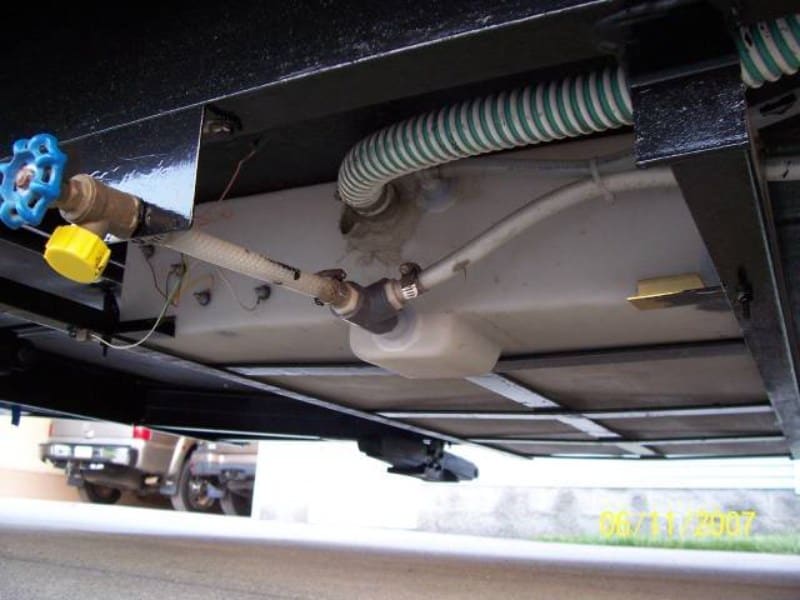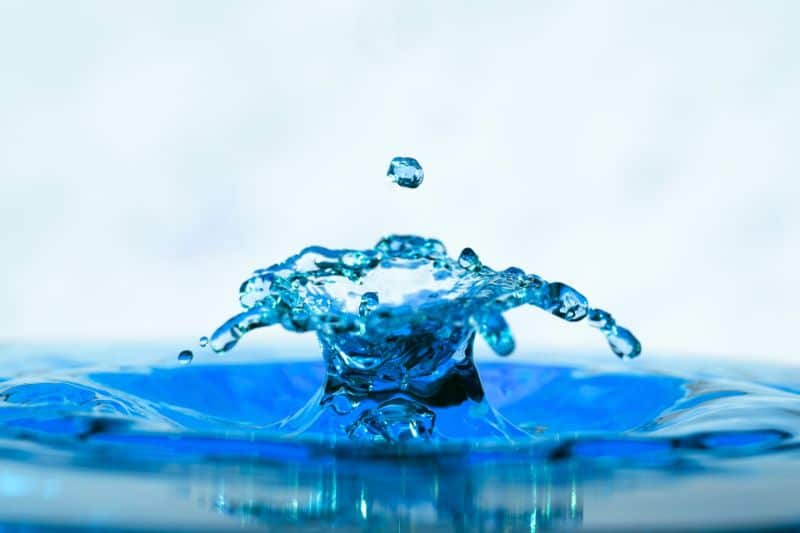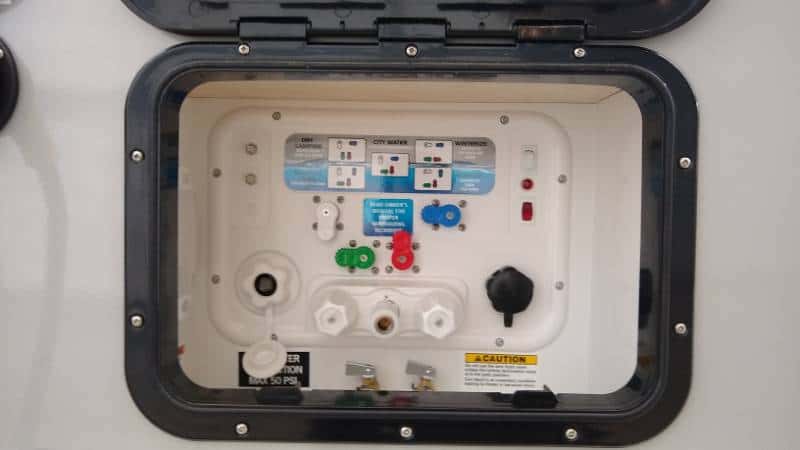Hopefully, you’re reading this post before embarking on your epic 2-week RVing adventure – not because your wife is throwing up in the RV bathroom and you’re panicking that it’s your fault for not sanitizing the water system. (Which, sadly, it is.)
As an RVer, you’re in charge of your own utility hookups. Anytime you aren’t connected to a city/campground water source, you’re in charge of your own freshwater!
And since we all know freshwater doesn’t stay fresh … just how long does the bacterial clock tick? How long can you let water sit in an RV tank before it goes bad?
(Pro Tip: The correct answer is NOT “until I feel queasy.”)
How Long Can I Let Water Sit in My RV Fresh Water Tank?

Short Answer: You can keep water in a RV freshwater tank for 10-14 days maximum.
Let me ask it another way: Would you be comfortable drinking out of a jug of water that had sat outside for 10 days?
If you’re filling up with water from non-municipal sources, such as a natural well, then your timeline could be significantly shorter. Quality in = quality out! If you fill up your tank with water of questionable cleanliness, then don’t expect to let it sit for two weeks. You’ll be starting your own bacterial zoo.
Let’s look at the factors that shorten or extend the amount of time you can store water in an RV tank.
What Extends Your Water’s Lifespan
- Regular system use
- Inline water filter*
- Clean, sanitized tank
- Clean, sanitized fill water hose
- Chilly weather
Assuming you are filling a clean tank with clean water, you can usually get about two weeks out of it.
(This is assuming you’re filling your tank once and letting the liquid sit. If you’re continually filling and depleting your water tank, you can go several months before your water tank needs to be drained and cleaned. Many full-timers drain and sanitize their system 2x a year.)
*Important Note on RV Water Filters
If you are using clean municipal water, you should probably NOT use an antibacterial inline water filter with activated carbon. Activated carbon will react with residual chlorine, which will reduce the lifespan of the drinking water. Instead, use a 5-micron mechanical or sediment filter only.
However, if you are using water from non-municipal or questionable sources (e.g. Flint Michigan), then definitely use an anti-bacterial inline water filter. Well water has no chlorine. And since you don’t know what’s in the water … best not to find out!
- Another option, which is sort of the best of both worlds, is to use a 5-micron sediment filter at the water inlet and a 1-micron antibacterial filter at all the faucets. Then you’re fully protecting your drinking water, but you’re not eliminating valuable chlorine in your tank. This setup works for both city and well water.
- Or a second option is to add your own bleach! Use a regular antibacterial water filter at the inlet and add a few drops of bleach if you know you’ll be camping more than a weekend. This setup works for both city and well water. However, if you forget to add bleach, or you add too much/too little, you’ve only exchanged one problem for another.
What Shortens Your Water’s Lifespan?
- Dirty or unfiltered water (e.g. well water)
- Unsanitized tank
- Unsanitized fill water hose
- Hot weather
I cannot emphasize this point enough: Your water is only as clean as your equipment! A dirty tank or fill hose can contaminate water from any source. Keep it clean!
Heat can significantly reduce the amount of time you can store water in your freshwater tank. Bacteria reproduce exponentially faster in a warm environment. Even though your tank is protected from direct sunlight, asphalt and concrete can radiate tremendous heat through your subfloor!
Should I Leave Water In My RV Fresh Water Tank?
Water itself doesn’t become stagnant – it’s all the bacteria and algae swimming inside of it! If your water, tank, or hose is contaminated, then bacteria will quickly colonize standing water. There’s plenty of oxygen in an RV tank for water to feed bad bacteria.
Warm temperatures accelerate this process. In hot weather, your water won’t stay fresh as long. It can also take on a burnt, plastic-y taste from the plastic tank itself. No good! You wouldn’t drink water that had been sitting inside a plastic bottle in your car for two weeks, would you?
When does water become unsafe to drink? Well, without microbiological water analysis, there’s no way to know for sure. Trust your senses. If you taste plastic, smell an odor, or get queasy after chugging a cup, then don’t trust the water!
You may be able to still use degraded water for gray water purposes, like bathing or washing dishes.
Here are some tips for keeping your RV drinking water system clean:
- Use a dedicated fill water hose, and cap the ends when not in use!
- Sanitize your fill water hose every 3-6 months.
- NEVER store your fill water hose in the same compartment as any sewage equipment!
How Do I Keep My RV Water Fresh?

What happens if you think your water has gone bad – but you have no other options? Say you’re boondocking, and you need to make the water last another four days. What can you do?
You need to wage war against the microbes taking over your water supply. Unfortunately, many of the traditional water purification methods – mechanical filtering, iodine, boiling, etc. – aren’t feasible once the water is already inside your tank.
That leaves an ol’ classic: chlorine bleach. Chlorine is used in almost all water disinfection plants in the United States! It kills many bacterial, viral, and parasitic pathogens. The water you’ve been drinking your entire life (if you didn’t have a well) was likely chlorinated.
You might be able to extend the lifespan of your RV fresh water by adding chlorine bleach to your water tank.
I caution you – there are many ways to mess this up! And chlorine is not a magic bullet! It doesn’t effectively kill giardia parasites, for instance. It doesn’t get rid of chemical pollution, either. So sterilizing water with bleach is considered an emergency tactic only.
- Clorox recommends using Disinfecting Bleach. Don’t use anything scented or splashless!
- Use approximately 1 teaspoon of chlorine bleach for every 10 gallons of freshwater. If you use more, you’ll need to flush the system.
- Let stand for 30 minutes. Rock the tank back and forth, if you can, to help mix in the bleach.
- Turn on a faucet and taste the fresh water. It should have a slight, almost unnoticeable trace of chlorine smell. No chlorine smell = probably not enough bleach. Strong smell = way too much.
See this EPA Guide for more detailed instructions.
Again – there are a lot of ways to screw this up. If you filled up your tank with lake water out of desperation, for instance, you’ll need to drain, flush and sanitize your entire system – not just your tank.
Can I Travel with a Full Freshwater Tank in My RV?
Sure. No law says you can’t! Of course, water weighs a lot. And it will impact your fuel economy – but in most cases, not much.
In fact, I recommend always traveling with at least some freshwater! You never know when you might come across the perfect primitive getaway.
Although … your water tank might fall off. But that’s another story.
Can I Leave My RV Freshwater Tank Empty?
Yes, you should.
In fact, you should definitely drain and sanitize your freshwater tank before putting your RV into storage, or even pausing for a few weeks before summer trips.
RV Freshwater Tank – Simple FAQs
How Do I Fill My RV Freshwater Tank?

If you’re connected to city water, such as at a campground water hookup, then you don’t need any water in your tank! Your RV will gulp water directly from the hookup.
But if you need to fill up your tank for primitive camping or travel, then you’ll need to pour water into your “gravity” water fill using a freshwater hose
Alternatively, in most campers, you can turn an intake valve to fill up your tank when connected to city water. Be careful not to overflow, though! Shut off the water at or before the RV freshwater level tank indicators report a full tank. (Psst. If your level sensors aren’t working, check out this article!)
Where Can I Fill My RV Freshwater Tank?
Anywhere you can find clean water! You can either use your “gravity” fill, which is designed for non-pressurized use, or your “city” fill, which is designed for a municipal pressurized water hookup.
How Big Is the Freshwater Tank in an RV?
Most RVs have freshwater tanks from 20 to 75 gallons in size. Your Owner’s Manual and Cargo Carrying Capacity (CCC) label should tell you how big your freshwater tank is.
How Do I Sanitize My RV Freshwater Tank?
A full discussion of how to maintain your RV water tank is beyond the scope of this article. In brief, you have two responsibilities:
Sanitize your water system to prevent the growth of mold, algae, bacteria, etc.
Winterize your water system to prevent pipe and tank damage from expanding frozen water.
At a bare minimum, you should sanitize 1-2x a year. Always sanitize the system when taking your RV out of storage. Depending on your circumstances, you might need to sanitize your system 1-2 a month!
And that’s my guide to keeping your water clean in your RV freshwater tank!
It’s not a bad idea to have a Plan B, either. Many campers travel with a jug of distilled water stored in a cool, dry place, just as emergency drinking water. Other campers travel with LifeStraws or other portable water filters.
Worst comes to worst, you can usually boil water on your stove for 5 minutes to kill off any pathogens. (That won’t help the plastic-y taste, though).
Happy camping!
Leave a Reply